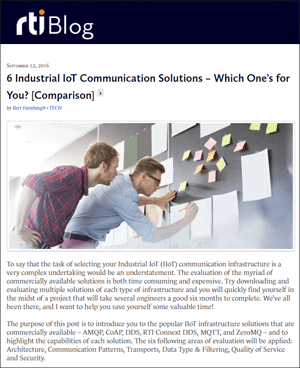 In LinkedIn’s Industrial Internet of Things group was a discussion topic, IIoT Protocols, Overview and Comparison. The discussion thread referenced an rti blog post, 6 Industrial IoT Communication Solutions – Which One’s for You? [Comparison]. The post describes the acronym-dense, commercially available communications technologies:
In LinkedIn’s Industrial Internet of Things group was a discussion topic, IIoT Protocols, Overview and Comparison. The discussion thread referenced an rti blog post, 6 Industrial IoT Communication Solutions – Which One’s for You? [Comparison]. The post describes the acronym-dense, commercially available communications technologies:
…AMQP, CoAP, DDS, RTI Connext DDS, MQTT, and ZeroMQ…
It describes the capabilities of each of these solutions. On the LinkedIn thread, Emerson’s Jonas Berge responded to the initial thread starter. He wrote [hyperlinks added by me]:
I personally believe the most important aspect is to select an open protocol so you are not tied to a single vendor with their proprietary protocol. Proprietary protocols limit solution options and long term support costs will be high. Expansions will be costly. If vendor goes bust you are left high and dry.
Going with standards is therefore critical so supporting organization / standard should be the top line in any comparison table.
For industrial sensors I personally believe the sensors themselves with have a local sensor network protocol such as Fieldbus or WirelessHART. AMQP, MQTT, and CoAP etc. come into play from the edge gateway up to the cloud when bandwidth is limited.
Learn more from this essay: https://www.linkedin.com/pulse/iot-standards-missing-jonas-berge
A discussion ensued on open protocols, integration burdens, role of OPC UA and XMPP protocols. Jonas added:
What often gets forgotten in protocol discussion is the absolute need for a standard namespace, hierarchical, object oriented. Most protocols don’t define the namespace well so every manufacturer does it differently. So a temperature transmitter from one manufacturer may have a variable called TEMPERATURE, but in another manufacturer’s device it is called TEMP, in a third is called PV, in a fourth it is called PRIMARY_VARIABLE and so on. In one device it is a 32 bit floating point value, in another a signed integer. In one it comes with a status byte, and another it doesn’t. In one device degrees Celsius is coded as 1001, in other it has another unit code, in a third it is a sting “degC” etc. In the process industries users demand interchangeability, over and above interoperability. They want to be able to replace a failed device with another device without messing with drivers or configure software. This requires very tight standards.
This is provided by industrial application protocols like FOUNDATION fieldbus and WirelessHART. This is what IIoT and IoT need as well. Learn more from this essay: https://www.linkedin.com/pulse/rich-data-poor-what-tells-software-does-jonas-berge
When questioned about namespaces and vocabularies, Jonas answered:
…I am thinking of protocols like FOUNDATION fieldbus which are object oriented and where every bit is defined. This makes it easy for control systems to display all the data in a device in an easy to use way: https://fieldcommgroup.org
You’ll need to join this IIoT LinkedIn group to read the whole thread with everyone’s point of view. You can also connect and interact with other Industrial Internet of Things experts in the Improve & Modernize and Wireless groups in the Emerson Exchange 365 community.

